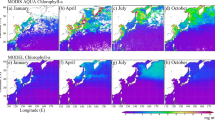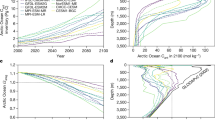Abstract
The global ocean Chlorofluorocarbon (CFC-11) was simulated in an offline model driven by re-analysis ocean currents in order to identify the mechanisms of interannual to interdecadal variability of air–sea CFC fluxes. The model was forced with the observed anthropogenic perturbations of atmospheric CFC-11 from the post industrial period (1938) following the OCMIP-II flux protocols along with the observed winds from 1960 to 1999 in the formulation of surface gas exchanges. The model ocean CFC-11 inventories, at the end of 1990s, accounted approximately 1% of the total atmospheric CFC-11, which is consistent with the corresponding observations. The mid-to-high latitude oceans were venue for strong (weak) oceanic sinks (sources) of CFC-11 during the winter (summer) months. The Southern Ocean (south of 40°S) and the North Atlantic (north of 35°N) provided two largest sinks of CFC-11, through which 31.4 and 14.6% of the global ocean CFC-11 entered, respectively. The eastern tropical Pacific Ocean exhibited large interannual variability of CFC-11 flux with a strong (weak) sink during La Niña (El Niño) years and represented 36% of the global CFC-11 flux variability. The North Atlantic and Southern Ocean were found as regions of large sink efficiency: a capacity to sink more CFC than outsource, although it reduced by 80 and 70%, respectively, in the last 40 years compared to 1960. The sink to source ratio of global ocean CFC-11 fluxes were reduced from 90 to 50% in the last 40 years. This indicates a saturation of CFC in the above-thermocline subsurface that makes the upper ocean less efficient in absorbing CFC in recent decades. A positive trend in CFC sink is now limited to the Southern Ocean, central tropical Pacific and western boundary current regions which possess active upwelling of old water with long time since last atmospheric contact. However, a globally averaged trend was a reduced CFC-11 sink, by emitting 30% of the total ocean CFC-11 that was absorbed during last 40 years.








Similar content being viewed by others
References
AFEAS (2002) Alternative flurocarbons environmental acceptability study (AFEAS). AFEAS data download
Bryan K, Lewis LJ (1979) A watermass model of the World ocean 84:2503–2517
Conkright ME, Locamini RA, Gracia HE, O’Brien TD, Boyer TP, Stephens C, Antonov JJ (2001) World ocean atlas 2001: objective analyses, data statistics and figures, CD-ROM Documentation. National Oceanographic Data Center, M. D., 17 pp
Craig AP, Bullister JL, Harrison DE, Chervin RM, Semtner AJ (1998) A comparison of temperature, salinity and chlorofluorocarbon observations with results from a 1° resolution three-dimensional global ocean model. J Geophys Res 103:1099–1119
Danabasoglu G, Peacock S, Lindsay K, Tsumune D (2009) Sensitivity of CFC-11 uptake to physical initial conditions and interannual varying surface forcing in a global ocean model. Ocean Model 29:58–65
Delworth TL et al. (2006) GFDL’s CM2 Global coupled climate models. Part I: formulation and simulation characteristics. J Clim 19:643–674
Doney SC, Bullister JL, Wanninkhof R (1998) Climate variability in upper ocean ventilation rates diagnosed using chlorofluorocarbons. Geophys Res Lett 25:1399–1402
Dutay JC et al (2002) Evaluation of ocean model ventilation with CFC-11; comparison of 13 global ocean models. Ocean Model 4:89–120
Elkins JW, Thompson TM, Swanson TH, Butler JH, Hall BD, Cummings SO, Fisher DA, Raffo AG (1993) Decrease in the growth rates of atmopsheric Chlorofluorocarbons 11 and 12. Nature 364:780–783
England MH, Garcon V, Minster JF (1994) Chlorofluorocarbon uptake in a world ocean model 1. Sensitivity to the surface gas forcing. J. Geophys. Res 99:25,215–25,233
Feely RA et al (2002) Sesonal and interannual variability of CO2 in the equatorial pacific. Deep-Sea Res 14:2443–2469
Gent PR, McWilliams JC (1990) Isopycnal mixing in Ocean circulation models. J Phys Oceanogr 20:150–155
Gnanadesikan A et al (2006) GFDL’s CM2 Global coupled climate models. Part II: the baseline ocean simulation. J. Clim 19:675–697
Griffies SM, Hallberg RW (2000) Biharmonic friction with a smagorinsky-like viscosity for use in large-scale eddy-permitting ocean models. J Phys Oceanogr 128:2935–2946
Houghton JT, Jenkins GJ, Ephraums JJ (1990) Climate change, The IPCC Scientific Assessment. Cambridge University Press, Cambridge, pp 365
Ishida A, Sasai Y, Yamanaka Y (2007) Roel of eddies in chlorofluorocarbon transport in wind-driven oceanic layers. J Phys Oceanogr 37:2491–2508
Key RM, Kozyr A, Sabine CL, Lee K, Wanninkhof R, Bullister JL, Feely RA, Millero FJ, Mordy C, Peng T-H (2004) A global ocean carbon climatology: results from Global Ocean Data Analysis Project (GLODAP). J Geophys Res 18. doi:10.1029/2004GB002247
Lachkar Z, Orr JC, Dutay JC, Delecluse P (2007) Effects of mesoscale eddies on global ocean distributions of CFC-11 CO2 and δ14c. Ocean Sci 3:461–482
Large WG, McWilliams JC, Doney SC (1994) Ocean vertical mixing: a review and a model with a nonlocal boundary layer parameterization. Rev. Geophys 32:363–403
Le-Quere C, Orr JC, Monfray P, Aumont O, Madec G (2000) Interannual variability of the oceanic sink of co2 from 1979 through 1997. Global Biogeochem Cycles 14:1247–1265
Le-Quere C, Rodenbeck C, Buitenhuis ET, Conway TJ, Langenfelds R, Gomez A, Labuschagne C, Ramonet M, Nakazawa T, Metzl N, Gillett N, Heimann M (2007) Saturation of the southern ocean CO2 sink due to recent climate change. Science 316:1735–1738
Matsumoto K, Mignone BK (2005) Model simulations of carbon sequestration in the north-west Pacific by direct injection. J Oceanogr Soc Jpn 61:747–760
McCulloch A, Ashford P, Midgley PM (2001) Historic emissions of fluoro-trichloromethane (CFC-11) based on a market survey. Atmos Environ 35:4387–4397
McPhaden MJ et al (1983) The tropical ocean-global atmosphere observing system: a decade of progress. J Geophys Res 103(C7):14169–14240
Sabine CL et al (2004) The oceanic sink for Anthropogenic CO2. Nature 305:367–371
Sarmiento JL, Gruber N (2006) Ocean biogeochemical dynamics. Princeton University Press, Princeton, 503 pp
Sasai Y, Ishida A, Yamanaka Y, Sasaki H (2004) Chlorofluorocarbons in a global ocean eddy-resolving OGCM: pathway and formation of Antarctic bottom water. Geophys Res 31. doi:10.1029/2004GL019895
Sen Gupta A, England M (2004) Evaluation of interior circulation in a high-resolution global Ocean model. Part I: deep and bottom waters. J Phys Oceanogr 34:2592–2614
Takahashi T, Sutherland SC, Sweeney C, Poisson A, Metzl N, Tilbrook B, Bates N, Wanninkhof R, Feely RA, Sabine C, Olafsson J, Nojiri Y (2002) Global sea–air CO2 flux based on climatological surface ocean pCO2 and seasonal biological and temperature effect. Deep-Sea Res 49:1601–1622
Taylor KE (2001) Summarizing multiple aspects of model performance in a single diagram. J Geophys Res 106:7183–7192
Uppala S, Kallberg P, Hernandez A, Saarinen S, Fiorino M, Li X, Onogi K, Sokka N, Andrea U, Bechtold VC (2004) ERA-40:ECMWF 45-year reanalysis of the global atmopshere and surface conditions 1957–2002. ECMWF Newslett 101:2–21
Valsala KV, Ikeda M (2007) Pathways and effects of the Indonesian Throughflow water in the Indian Ocean using Particle trajectory and Tracers in an OGCM. J Clim 20:2994–3017
Valsala KV, Maksyutov S, Ikeda M (2008) Design and validation of an offline oceanic tracer transport model for a carbon cycle study. J Clim 21:2752–2769
Walker SJ, Weiss RF, Salameh PK (2000) Reconstructed histories of the annual mean atmospheric mole fractions for halocarbons CFC-11, CFC-12, CFC-13, and carbon tetrachloride. J Geophys Res 105:14285–14296
Wanninkhof R (1992) Relationship between wind speed and gas exchange over the ocean. J Geophys Res 97:7373–7382
Warner MJ, Bullister JL, Wisegarver DP, Gammon RH, Weiss RF (1996) Basin-wide distributions of chlorofluorocarbons CFC-11 and CFC-12 in the north Pacific: 1958–1989. J Geophys Res 101:20525–20542
Willey DA, Fine RA, Sonnerup RE, Bullister JL, Smethie WM (2004) Global oceanic chlorofluorocarbon inventory. Geophys Res Lett 31. doi:10.1029/2003GL018816
Zheng M, DeBruyn WJ, Saltzman ES (1998) Measurements of the diffusion coefficients of cfc-11 and cfc-12 in pure water and seawater. J Geophys Res 103:1375–1379
Acknowledgments
We are thankful to the financial support from GOSAT project operating at NIES. The first author is supported as a Japanese Society for the Promotion of Science (JSPS) fellow at CGER, NIES. The computational resources are provided by the supercomputing facilities at NIES. The reanalysis data is taken from GFDL, Princeton, New Jersy. Comments and suggestions from various modeling groups inside and outside of Japan have helped to pinpoint and troubleshoot our model physics and code. The comments from two anonymous reviewers were instrumental to improve the quality of the manuscript and are acknowledged here.
Author information
Authors and Affiliations
Corresponding author
Rights and permissions
About this article
Cite this article
Valsala, V., Alsibai, H.M., Ikeda, M. et al. Interannual variability of CFC-11 absorption by the ocean: an offline model study. Clim Dyn 36, 1435–1452 (2011). https://doi.org/10.1007/s00382-010-0784-4
Received:
Accepted:
Published:
Issue Date:
DOI: https://doi.org/10.1007/s00382-010-0784-4




